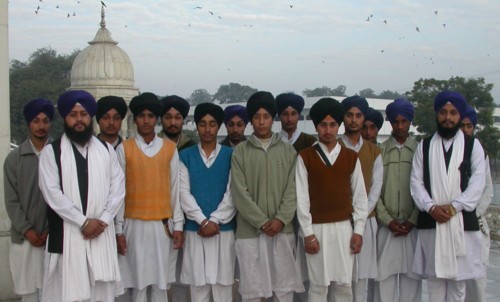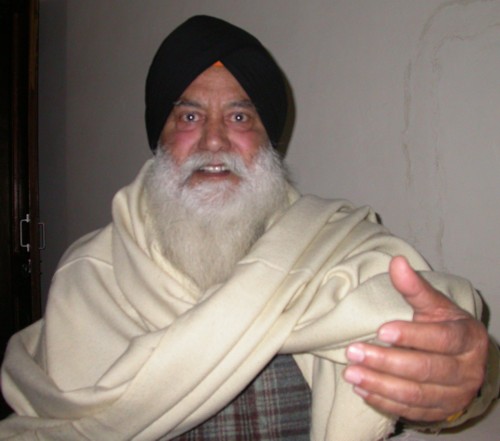Gurmat Vidyalaya at Rakabganj Sahib, Delhi
Hopkinton, MA
January 16, 2005
During a short business trip to Delhi last week, I had the opportunity to visit the Gurmat Vidyalaya at Rakabganj Sahib a couple of times. Fresh off a plane, jet lag my ally, I summoned a rental car, and went to Gurdwara Bangla Sahib to listen to the Asa Ki Var. A visit to Bangla Sahib in the wee hours of the morning is always energizing. However I could not suppress a twinge of disappointment at the somewhat banal, commercialized rendition of Kirtan by the presiding Jatha.
My attention wavering, I got up to leave after about 45 minutes and asked my driver to head back to my hotel. On an impulse, I asked him to take me to Gurdwara Rakabganj instead. In sharp contrast to Bangla Sahib, Rakabganj bears a somewhat deserted look in the mornings. Asa Ki Var at Rakabganj begins not at 5 a.m. but an hour later. As I entered the Gurdwara, I heard the first Paudi of Asa Ki Var being sung in seemingly girlish, unpolished voices. It was however, being rendered in Raga Asa, as it should be, according to the traditions of Gurmat Sangeet. I saw three young Singhs, perhaps about thirteen or fourteen, threadbare shawls on thier shoulders in perhaps a futile attempt to ward off the January chill, spiritedly rendering our magnifcent morning ballad, as it has been sung for centuries.
I sat down to listen and was transfixed for the next hour. The young kirtaniyas, with great gusto sang the first four Paudis in Raga Asa followed by Raga Bhairav. The shabads they sang were also traditional compositions in the same Ragas. The urgent tug of the meetings that had brought me to Delhi cut short the wonderful experience and I hurried back to my hotel, energized and renewed by the sincere and soulful Kirtan of the young Kirtaniyas, determined however to return.
The Gurmat Vidyalaya at Rakabganj, which is where these young Kirtaniyas in-training are from is one of the premier institutions in the Panth where the traditions of Gurmat Sangeet are taught today. The Vidyalaya has been run since 1967 by the redoubtable Gyani Dyal Singh Ji.
(To learn more about Gyaniji, go to http://www.gurmatsangeetproject.com/Pages/DyalSingh.asp)
I had first met Gyaniji at the Long Island Gurdwara in 1992, when he was visiting with Bhai Surjit Singh, an excellent Kirtaniya and one of his senior-most students. Gyaniji has had a profound impact on me and has in no small part provided considerable inspiration to the Gurmat Sangeet Project (www.gurmatsangeetproject.com) without even being aware of it ! I had met him a second time in the mid 90s at Bridgewater New Jersey, when he visited the Gurdwara and spoke about Gurmat Sangeet. It was however, with some trepidation that I called him that afternoon, because Gyaniji has the temperament of ascetic and does not take kindly to distractions from his work with the children at the Vidyalaya.
The next day being Lohri, I armed myself with fruit and mathiai for the children of the Vidyalaya and made my way to Rakabganj Sahib. Gyaniji had asked me to come at around 5 p.m. which is when the children take a break from lessons. I do not have words to describe the next couple of hours. Gyani Dyal Singh Ji, ascetic demeanor notwithstanding, turned out to be warm, passionate about Gurmat Sangeet and one of the most straightforward persons that I have ever met ! I got a veritable history lesson on the founding of the Gurmat Vidyalaya, Gyani Dyal Singh Ji's teacher, Gyani Hardit Singh Ji and Gyaniji's groundbreaking collboration with Gian Singh Ji Abbotbad, and the Rababi Bhai Taba Ji, which resulted in the documenting and preservation of ancient melodies employed for Kirtan from the very times of the Gurus !
We also spent time commiserating with each other on the sorry state of Gurbani Kirtan today where mediocrity and money rule with scant regard for the traditions of Gurmat Sangeet and often, utter neglect for the few exponents who choose to remain true to the traditional path. The most uplifting part of the conversation was brainstorming what could be done to encourage and support the few stalwarts who continue to preserve the traditions of Gurmat Sangeet.Two hours later, I reluctantly tore myself away, ( I had to see a Man about a Tanpura !) but I left, uplifted and energized. Our brainstorming on what can be done is a subject for another post.
I had to return to Boston the next day, but there was one more treat in store for me. Gyaniji picked some of his most adept students and invited one of the practicing Jathas that has studied with him, to sing the Asa Ki Var the next morning at Rakabganj Sahib. It was truly a sublime experience, listening to the beautiful kirtan; the children and the Ragis offered to the Sangat, a soulful rendition of Asa Ki Var in Morning Ragas such as Asa, Bhairav, Ahir Bhairav, and Asavari, interspersed with magnificent shabads, sung in prescribed or Nirdharat Ragas, including Partals in Asa & Bhairav. I had the good fortune to record the entire Asa Ki Var; the recordings will appear shortly on www.gurmatsangeetproject.com
What a contrast ! On the one hand the banal, soulless singing that I heard the first day, that so disappointed me ! On the other, the youthful energetic renditions, steeped in the traditions bestowed upon us by our Gurus, no less ! And the tantalizing promise of a Renaissance !
The Kirtaniyas of tomorrow !
 .
.
Gyani Dyal Singh Ji - holding forth !



1 Comments:
Yes, I agree, we are straying away from the gurmat sangeet traditions that the gurus set forth and I believe its very important to stick to the ways of the gurus. Anyway, I enjoyed the post - I'm definately inspired to go to gurdwara Rakabganj Sahib now! Sounds like you had an amazing experience!!
February 1, 2005 at 4:40 PM
Post a Comment
<< Home